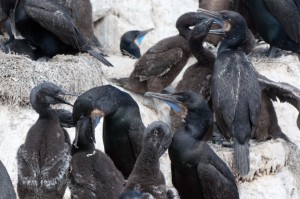Our prior post detailed the NW half of our 4 Corners circuit, capturing visits to the Grand Canyon, Zion, Bryce Canyon, Capital Reef, as well as multiple National Monuments and state parks en route. Turning south when we reached I-70 in Utah, we gradually moved toward warmer weather…
9-11 Oct: Canyonlands N.P. –
The Canyonlands campground was full – as was that at the adjacent state park – so we found a nice BLM site, Cowboy Campground, just down the road. Water is scarce here,  delivered by truck to these parks, but we were able to fill our containers at the National Park. It is beautiful, but nights are almost freezing. On the 10th we drove to
delivered by truck to these parks, but we were able to fill our containers at the National Park. It is beautiful, but nights are almost freezing. On the 10th we drove to  adjoining Dead Horse State Park as we were told (incorrectly) that camping might be available. We toured their great visitors center displays and took a nice 3 mile hike, learning about the fascinating primative but complex little creatures that live in transient water holes in the rocks. Great canyon views too! We then drove into
adjoining Dead Horse State Park as we were told (incorrectly) that camping might be available. We toured their great visitors center displays and took a nice 3 mile hike, learning about the fascinating primative but complex little creatures that live in transient water holes in the rocks. Great canyon views too! We then drove into  Canyonlands NP “Island in the Sky” section, stopping at several overlooks, taking a short hike to
Canyonlands NP “Island in the Sky” section, stopping at several overlooks, taking a short hike to  Mesa Arch, and hiking about 2 miles round trip to the 2nd lookout over Upheaval Dome. On the way back to our $8/night BLM campsite, we strolled around Grand View and Sunset Points – with quite a view over the surrounding canyons.
Mesa Arch, and hiking about 2 miles round trip to the 2nd lookout over Upheaval Dome. On the way back to our $8/night BLM campsite, we strolled around Grand View and Sunset Points – with quite a view over the surrounding canyons.
11-14 Oct: Arches N.P and Moab –
We drove into Moab early the next morning and found an RV park by the Colorado 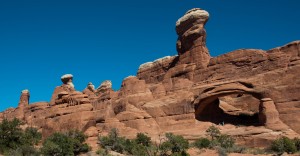 river. We shopped, washed clothes and the van, took warm showers, and generally had a leisurely day. On the 12th we visited Arches, stopping by several view
river. We shopped, washed clothes and the van, took warm showers, and generally had a leisurely day. On the 12th we visited Arches, stopping by several view  points with short hikes on our drive 8.5 miles out a gravel road in “Salt Valley” There we hiked 3.4 miles r.t. to Tower Arch. A dozen other hikers had
points with short hikes on our drive 8.5 miles out a gravel road in “Salt Valley” There we hiked 3.4 miles r.t. to Tower Arch. A dozen other hikers had picnic lunches with us under the arch. Beautiful. Next we drove back to the Windows Section and saw Double Arch, Turret Arch, and the N. and S. Windows arches on about a 1.5 mile hike. To cap the day, we drove to the Delicate Arch parking lot and hiked 100 ft to Wolfe
picnic lunches with us under the arch. Beautiful. Next we drove back to the Windows Section and saw Double Arch, Turret Arch, and the N. and S. Windows arches on about a 1.5 mile hike. To cap the day, we drove to the Delicate Arch parking lot and hiked 100 ft to Wolfe 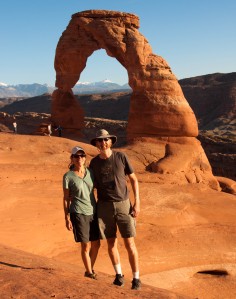 Ranch and a nice panel of Ute petroglyphs – men on horses….We hike on, a busy 3 mile r.t. trail, to Delicate Arch and joined an entertaining throng of onlookers who watched and photographed the sunset and Arch before we all walked quickly back through the gathering gloam. The next day we went in search of the Courthouse Wash Rock Art, driving down the road and then hiking back to find it just across the road from our campground. It is very faded (badly vandalized) but contains older large figures in the Barrier Canyon style; archaic, ghost-
Ranch and a nice panel of Ute petroglyphs – men on horses….We hike on, a busy 3 mile r.t. trail, to Delicate Arch and joined an entertaining throng of onlookers who watched and photographed the sunset and Arch before we all walked quickly back through the gathering gloam. The next day we went in search of the Courthouse Wash Rock Art, driving down the road and then hiking back to find it just across the road from our campground. It is very faded (badly vandalized) but contains older large figures in the Barrier Canyon style; archaic, ghost- like (some say martian-like?) red painted figures. The panel also had rock-art figures from a later period along with superimposed warrior shields from the Ute Indian time and unfortunately significant
like (some say martian-like?) red painted figures. The panel also had rock-art figures from a later period along with superimposed warrior shields from the Ute Indian time and unfortunately significant  graffiti from our latest period as well. We then drove back into Arches N.P. to the Devil’s Garden Trailhead and hiked
graffiti from our latest period as well. We then drove back into Arches N.P. to the Devil’s Garden Trailhead and hiked the roughly 8 mile loop trail by at least seven great arches, visiting them all. This is a superb hike. The trail led over long rock fins with drop-offs on both sides, the rock formations and vistas were incredible, and the return hike
the roughly 8 mile loop trail by at least seven great arches, visiting them all. This is a superb hike. The trail led over long rock fins with drop-offs on both sides, the rock formations and vistas were incredible, and the return hike  had some very nice scrambling on a tougher trail. Can you see Judi on the rock fin over the arch in the photo below?
had some very nice scrambling on a tougher trail. Can you see Judi on the rock fin over the arch in the photo below?  After re-joining the main trail, we were fortunate to see a small rattlesnake (pygmy or juvenile?) crossing the trail.
After re-joining the main trail, we were fortunate to see a small rattlesnake (pygmy or juvenile?) crossing the trail.  We next hiked to Sand Dunes Arch – an interesting 1/3 mile walk between rocky fins with adjacent sand drifts. I hiked on another 1.3 miles r.t to Broken Arch, spotting lizards but no other snakes. On our return drive, we stopped by the Balanced Rock and then by Park Avenue before leaving the park and driving 5 miles down the nearby Rt. 279 (Potash Rd.).
We next hiked to Sand Dunes Arch – an interesting 1/3 mile walk between rocky fins with adjacent sand drifts. I hiked on another 1.3 miles r.t to Broken Arch, spotting lizards but no other snakes. On our return drive, we stopped by the Balanced Rock and then by Park Avenue before leaving the park and driving 5 miles down the nearby Rt. 279 (Potash Rd.).  This brought us to a 125 foot long panel of Indian rock art from the Formative Period – paperdoll cutouts,
This brought us to a 125 foot long panel of Indian rock art from the Formative Period – paperdoll cutouts,  horned figures with shields, etc. Two hundred feet further down the road were more, including a large bear with 3 small hunters wielding spears around it. Another 3/4 mile
horned figures with shields, etc. Two hundred feet further down the road were more, including a large bear with 3 small hunters wielding spears around it. Another 3/4 mile  brought us to more petroglyphs and also Dinosaur Tracks! Tracks of Allosaurus, a 3-toed dinosaur, which included
brought us to more petroglyphs and also Dinosaur Tracks! Tracks of Allosaurus, a 3-toed dinosaur, which included 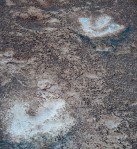 both imprints on one rock and the reverse 3-toed protrusions on an adjacent rock. These are at the
both imprints on one rock and the reverse 3-toed protrusions on an adjacent rock. These are at the  Navajo/Kayenta sandstone interface and apparently another half-dozen carnivorous dinosaurs also left their tracks on that hillside (but we couldn’t find them). The next morning we continued our Moab Indian rock-art tour, visiting among several others, the incredible “Birthing Scene”
Navajo/Kayenta sandstone interface and apparently another half-dozen carnivorous dinosaurs also left their tracks on that hillside (but we couldn’t find them). The next morning we continued our Moab Indian rock-art tour, visiting among several others, the incredible “Birthing Scene”  rock (below R) on the other side of the river and, on the way out of town, the “Moab Man” pictured at left.
rock (below R) on the other side of the river and, on the way out of town, the “Moab Man” pictured at left.
14-16 Oct: Hovenweep N.M. –
Ancestral Pueblo Indians (previously called Anasazi) built small groups of stone buildings and towers around the ravines in this area mainly between 1200-1300 A.D. The main group of structures are called Square Tower after a prominent central structure, and we started our exploration with the 1.5 mile hike around this area that encompasses about 10 fairly small ruins. (This  trail passed by the campground, and Dave returned for the next two mornings to hike the circuit at sunrise.) On the 15th we took a ranger-led tour off the permitted trail to a
trail passed by the campground, and Dave returned for the next two mornings to hike the circuit at sunrise.) On the 15th we took a ranger-led tour off the permitted trail to a  small group of petroglyphs that included 3 macaws, colorful birds that never flew within hundreds of miles of Hovenweep but were imported in early Indian trade. After lunch we took an ambitious 25 mile bike ride (the first 12 miles uphill) to visit the small ruins at the
small group of petroglyphs that included 3 macaws, colorful birds that never flew within hundreds of miles of Hovenweep but were imported in early Indian trade. After lunch we took an ambitious 25 mile bike ride (the first 12 miles uphill) to visit the small ruins at the  former communities of Holly, Horseshoe, Hackberry, and Cutthroat Castle. Each of these sites had interesting old stone buildings and towers, some perched on large boulders in the ravine. Our ride back was long, fast, and increasingly dark. After a quick supper, we attended a great astronomy program led by an energetic and engaging ranger. We saw the Andromeda galaxy and its resident binary star, 4 of the moons and 2 bands on Jupiter, and close-ups of our moon. The next morning we drove to and hiked around the remaining Hovenweep community of ruins, named Cajon, before driving on.
former communities of Holly, Horseshoe, Hackberry, and Cutthroat Castle. Each of these sites had interesting old stone buildings and towers, some perched on large boulders in the ravine. Our ride back was long, fast, and increasingly dark. After a quick supper, we attended a great astronomy program led by an energetic and engaging ranger. We saw the Andromeda galaxy and its resident binary star, 4 of the moons and 2 bands on Jupiter, and close-ups of our moon. The next morning we drove to and hiked around the remaining Hovenweep community of ruins, named Cajon, before driving on.
16-17 Oct: Mesa Verde NP and Aztec NM –
After a quick half mile hike in the Canyon of the Ancients near Castle Rock, we drove on to Mesa Verde, arriving after lunch. The Aspen, Cottonwood and Oak trees along the way put on quite a show with their yellow and orange leaves. Most of Mesa Verde was closed for the season, but we quickly hiked the self- guided trail through Spruce Tree House, took the 1600 (last) ranger-guided tour of Cliff Palace, and drove the 6-mile Mesa Top Loop, stopping at each site to see ruins that illustrated the evolution of the Ancestral Pueblo architecture
guided trail through Spruce Tree House, took the 1600 (last) ranger-guided tour of Cliff Palace, and drove the 6-mile Mesa Top Loop, stopping at each site to see ruins that illustrated the evolution of the Ancestral Pueblo architecture and culture. Spruce Tree House and Cliff Palace are both incredible. Stabilized and and partially rebuilt,
and culture. Spruce Tree House and Cliff Palace are both incredible. Stabilized and and partially rebuilt,  they well capture the magnitude and beauty of these villages that were built below towering cliffs. One isn’t alone and doesn’t get the sense of Hovenweep’s small, quiet, abandoned ruins in their natural setting – but these Mesa Verde ruins are much larger and more impressive. Leaving with an incredible sunset, we struck out with nearby camping, eventually driving into the nearby National Forest to free camp by a logging road.
they well capture the magnitude and beauty of these villages that were built below towering cliffs. One isn’t alone and doesn’t get the sense of Hovenweep’s small, quiet, abandoned ruins in their natural setting – but these Mesa Verde ruins are much larger and more impressive. Leaving with an incredible sunset, we struck out with nearby camping, eventually driving into the nearby National Forest to free camp by a logging road.  On the 17th, we had a can’t-be-beat pancake breakfast at a diner in the cute town of Mancos CO before driving through a beautiful aspen-laced valley to Durango. We pulled in just as the morning train left and took a nice stroll around town, looking also at the cute residential areas. Seeing the wintertime temperatures and snowfall, we drove quickly on, heading south into New Mexico. Stopping at Aztec National Monument, we took their self-guided tour (with a nice booklet) through a huge, partially excavated Ancestral Pueblo site containing about 500 rooms with low ceilings and lower
On the 17th, we had a can’t-be-beat pancake breakfast at a diner in the cute town of Mancos CO before driving through a beautiful aspen-laced valley to Durango. We pulled in just as the morning train left and took a nice stroll around town, looking also at the cute residential areas. Seeing the wintertime temperatures and snowfall, we drove quickly on, heading south into New Mexico. Stopping at Aztec National Monument, we took their self-guided tour (with a nice booklet) through a huge, partially excavated Ancestral Pueblo site containing about 500 rooms with low ceilings and lower doors. (And there was an adjacent, unexcavated site of similar size!) In addition to the impressive size of the ruins, most noteworthy was a restored giant kiva. All Ancestral Pueblo ruins are associated with one or often many underground kivas, and while their structure evolved some over time, they all
doors. (And there was an adjacent, unexcavated site of similar size!) In addition to the impressive size of the ruins, most noteworthy was a restored giant kiva. All Ancestral Pueblo ruins are associated with one or often many underground kivas, and while their structure evolved some over time, they all  had a central firepit and were entered from the top by way of a ladder (through the smoke). Serving religious but also probably many functions, each family unit had a kiva – but these Giant Kivas were impressive common meeting and “worship?” places where key members of their communities could gather.
had a central firepit and were entered from the top by way of a ladder (through the smoke). Serving religious but also probably many functions, each family unit had a kiva – but these Giant Kivas were impressive common meeting and “worship?” places where key members of their communities could gather.
17-20 Oct: Chaco Cultural National Historic Park –
Continuing our Indian Ruins tour, we drove on to Chaco National Historic Park, slowly driving the last 10 miles over a rough dirt road that rattled our camper and bones – and cracked our windshield. Chaco is a World Heritage Site, and was at the heart of the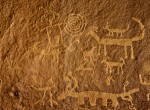 Ancestral Puebloan world for several hundred years. We camped for three nights in a unique campground with cliff
Ancestral Puebloan world for several hundred years. We camped for three nights in a unique campground with cliff  dwelling ruins just 50 feet from our site. The first evening we took a one mile r.t. hike to the unexcavated (or re-covered) Una Vida site (150 rooms, 5 kivas) and saw some great petroglyphs. We then drove the 9 mile loop road, seeing huge ruins and about a dozen elk. On the 18th we took a
dwelling ruins just 50 feet from our site. The first evening we took a one mile r.t. hike to the unexcavated (or re-covered) Una Vida site (150 rooms, 5 kivas) and saw some great petroglyphs. We then drove the 9 mile loop road, seeing huge ruins and about a dozen elk. On the 18th we took a  morning guided tour of Pueblo Bonito, the largest of about 150 Chacoan great houses in the Four Corners area. Impressive! While it was originally thought that these great houses were huge apartment buildings, it is now felt they were more like community centers and temples,
morning guided tour of Pueblo Bonito, the largest of about 150 Chacoan great houses in the Four Corners area. Impressive! While it was originally thought that these great houses were huge apartment buildings, it is now felt they were more like community centers and temples,  serving as major sites of community ceremonies as well as storage, trading, and communication. Pueblo Bonito was built between 850-1150 A.D. and was at least 4 stories tall with over 600 rooms and 40 kivas! We then hiked a nice petroglyph trail
serving as major sites of community ceremonies as well as storage, trading, and communication. Pueblo Bonito was built between 850-1150 A.D. and was at least 4 stories tall with over 600 rooms and 40 kivas! We then hiked a nice petroglyph trail to the adjacent Chetro Ketl great house, the 2nd largest that was also at least 4 stories and had 500 rooms. These two huge structures were built with
to the adjacent Chetro Ketl great house, the 2nd largest that was also at least 4 stories and had 500 rooms. These two huge structures were built with  large open courtyards and seemed to overlap. We next drove to another great house a few miles down the road, Pueblo del Arroyo, that was closed for repairs. From there we biked to a smaller (100 room, 5 kiva) great house called Kin Kletso and then on to Casa Chiquita, a similar sized great house built around AD 1060. At the end of that 1 mile trail, we hike another 5.5 miles r.t., first to the “Supernova” pictograph site and then on to Penasco Blanco, another huge great house situated on the mesa above the canyon but with a
large open courtyards and seemed to overlap. We next drove to another great house a few miles down the road, Pueblo del Arroyo, that was closed for repairs. From there we biked to a smaller (100 room, 5 kiva) great house called Kin Kletso and then on to Casa Chiquita, a similar sized great house built around AD 1060. At the end of that 1 mile trail, we hike another 5.5 miles r.t., first to the “Supernova” pictograph site and then on to Penasco Blanco, another huge great house situated on the mesa above the canyon but with a 
 perfect line-of-site to Pueblo Bonito. (You get the idea; there are many huge ruins that are largely unexcavated.) That evening we attended a great lecture on the astrology of the Chacoans, learning how they aligned structures to within 1 degree of true N-S and E-W directions and placed markers on their buildings to signal events like the winter and summer solstices. Really impressive – and great stars! Chaco is far from any city lights (or cell phone reception) and is the only N.M. with its own observatory! The next morning it was 31degrees when we got up – brrr. We drove back to Pueblo del Arroyo, biked to Kin Kletso, and took the Pueblo Alto Trail, ascending to the upper plateau through a crack in the rocks filled with rubble just as the Chacoans did 1000 years prior. We hiked over rocks that were once at the bottom of an ancient sea and contained many
perfect line-of-site to Pueblo Bonito. (You get the idea; there are many huge ruins that are largely unexcavated.) That evening we attended a great lecture on the astrology of the Chacoans, learning how they aligned structures to within 1 degree of true N-S and E-W directions and placed markers on their buildings to signal events like the winter and summer solstices. Really impressive – and great stars! Chaco is far from any city lights (or cell phone reception) and is the only N.M. with its own observatory! The next morning it was 31degrees when we got up – brrr. We drove back to Pueblo del Arroyo, biked to Kin Kletso, and took the Pueblo Alto Trail, ascending to the upper plateau through a crack in the rocks filled with rubble just as the Chacoans did 1000 years prior. We hiked over rocks that were once at the bottom of an ancient sea and contained many  unusual fossils including thousands of branching tubes (“shrimp burrows” according to the park). We walked through New Pueblo, a smallish residential structure of probably <100 rooms, and then across a field to Pueblo Alto, another huge unexcavated great house. The
unusual fossils including thousands of branching tubes (“shrimp burrows” according to the park). We walked through New Pueblo, a smallish residential structure of probably <100 rooms, and then across a field to Pueblo Alto, another huge unexcavated great house. The  Chacoans used to break pottery as part of their religious offering, and in places, the ground was littered with pottery shards. Walking on
Chacoans used to break pottery as part of their religious offering, and in places, the ground was littered with pottery shards. Walking on  sections of old Chacoan roads (that fanned out from Pueblo Bonito in all directions), we hiked by a large Chacoan stairway, chipped in the rock and climbing a cliff to the mesa. This one originally had hand rails. The loop trail followed an old Chacoan “highway” along the mesa cliff-top, past circles of stones and great vistas of the great house ruins below. After lunch we looked at more petroglyphs, hiked through more
sections of old Chacoan roads (that fanned out from Pueblo Bonito in all directions), we hiked by a large Chacoan stairway, chipped in the rock and climbing a cliff to the mesa. This one originally had hand rails. The loop trail followed an old Chacoan “highway” along the mesa cliff-top, past circles of stones and great vistas of the great house ruins below. After lunch we looked at more petroglyphs, hiked through more  ruins including an excavated Giant Kiva, and biked the 3 mile r.t Wijiji trail from our campground to another unexcavated (3-story, 225 room) great house. What a fascinating and impressive place!
ruins including an excavated Giant Kiva, and biked the 3 mile r.t Wijiji trail from our campground to another unexcavated (3-story, 225 room) great house. What a fascinating and impressive place!
20-28 Oct: The Santa Fe N.M. area –
We drove from Chaco to Santa Fe and camped in an RV park near Eldorado, a planned subdivision about 10 miles SE of Santa Fe that is reportedly the largest solar community in the nation. On the 21st we drove through Eldorado, walked around the old town square in Santa Fe, and then descended on Dr. Richard Andre, one of our former USUHS professors. Dr. Andre is an Entomologist who worked closely with Judi in Peru as she did her DrPH research on Bartonella Bacilliformis. He and his wife (who was travelling in Asia with her work) live in a beautiful house above Santa Fe, and we  firmly ensconced ourselves in their beautiful Guest House. Over the next week we ate countless gourmet meals, met his delightful and very interesting neighbors, took the birdfeeders down at dusk to protect them from the neighborhood bears and put them back out in the morning, and took several hikes: to town for tea, 3.5 miles r.t. into the trails above the Audubon Society, and a hike of similar distance in the Carson National
firmly ensconced ourselves in their beautiful Guest House. Over the next week we ate countless gourmet meals, met his delightful and very interesting neighbors, took the birdfeeders down at dusk to protect them from the neighborhood bears and put them back out in the morning, and took several hikes: to town for tea, 3.5 miles r.t. into the trails above the Audubon Society, and a hike of similar distance in the Carson National  Forest 20 minutes away. On the 24th we visited Bandelier N.M., viewing small caves in
Forest 20 minutes away. On the 24th we visited Bandelier N.M., viewing small caves in  the volcanic cliffs, petroglyphs, remains of cliff dwellings, and interesting ruins of a 350 room circular stone town. At a second
the volcanic cliffs, petroglyphs, remains of cliff dwellings, and interesting ruins of a 350 room circular stone town. At a second  site there were more caves, ruins, petroglyphs, and most impressive
site there were more caves, ruins, petroglyphs, and most impressive  were deep paths in the soft volcanic rock that were worn down over many years by the prior inhabitants. The following day we toured about 10 houses in Eldorado with a realtor. There is little active solar but some of the houses are built with a passive solar design that warms them in the winter. Nice – but not entirely sold. The 26th was cold and rainy
were deep paths in the soft volcanic rock that were worn down over many years by the prior inhabitants. The following day we toured about 10 houses in Eldorado with a realtor. There is little active solar but some of the houses are built with a passive solar design that warms them in the winter. Nice – but not entirely sold. The 26th was cold and rainy  but undaunted, we took a beautiful drive with Dr. Andre to Taos, stopping along the way to see highlights in several small towns. In Taos we visited the church, strolled through the quaint downtown area, and touring the Earthship Project. While these largely
but undaunted, we took a beautiful drive with Dr. Andre to Taos, stopping along the way to see highlights in several small towns. In Taos we visited the church, strolled through the quaint downtown area, and touring the Earthship Project. While these largely  underground, stand-
underground, stand- alone Earthships are built with unusual materials and display some questionable workmanship, they do incorporate some fascinating technologies and ideas (like capturing
alone Earthships are built with unusual materials and display some questionable workmanship, they do incorporate some fascinating technologies and ideas (like capturing  rain water and
rain water and  then reusing all water 3 times). The following day we all visited the Santa Fe Folk Museum, and in the afternoon, Judi and I drove to Los Alamos and toured the very impressive Bradbury Science museum. With our clothes getting tight, we ate a final gourmet breakfast on the 28th and then left Dr. Andre and his wonderful hospitality, heading south.
then reusing all water 3 times). The following day we all visited the Santa Fe Folk Museum, and in the afternoon, Judi and I drove to Los Alamos and toured the very impressive Bradbury Science museum. With our clothes getting tight, we ate a final gourmet breakfast on the 28th and then left Dr. Andre and his wonderful hospitality, heading south.
28-29 Oct: Petroglyphs N.M. –
We stopped in Albuquerque at Petroglyphs N.M., planning to hike through and head on. However, we discovered  there were three different sections of the monument, all with trails along volcanic basalt boulder strewn cliffs with incredible petroglyphs –
there were three different sections of the monument, all with trails along volcanic basalt boulder strewn cliffs with incredible petroglyphs –  and we had become quite interested in this Indian rock
and we had become quite interested in this Indian rock 
 art. On the 28th we hiked Riconada Canyon but didn’t have time to hike the two other nearby sections –
art. On the 28th we hiked Riconada Canyon but didn’t have time to hike the two other nearby sections –  so we camped at nearby
so we camped at nearby Kirkland AFB and returned the next morning, hiking both Boca Negra and Piedras Macadra Canyons. Each of these trails is about 1.5 miles long and passes by large numbers of interesting Indian rock art chipped pictures as well as some Spanish graffiti.
Kirkland AFB and returned the next morning, hiking both Boca Negra and Piedras Macadra Canyons. Each of these trails is about 1.5 miles long and passes by large numbers of interesting Indian rock art chipped pictures as well as some Spanish graffiti.
29-31 Oct: Bosque del Apache National Wildlife Refuge:
 Leaving our petroglyphs, we drove south to Bosque, camping at a small RV park run by an aging couple outside the park. While we were a few weeks early (most migratory birds arrive in mid to later
Leaving our petroglyphs, we drove south to Bosque, camping at a small RV park run by an aging couple outside the park. While we were a few weeks early (most migratory birds arrive in mid to later  November), we saw large numbers of snow geese, greater sandhill cranes, and northern pintail ducks along with isolated western grebe, northern harrier hawks, Gamble quail, a roadrunner…. Sunrises were particularly impressive with huge flocks of snow geese feeding and then suddenly rising together and
November), we saw large numbers of snow geese, greater sandhill cranes, and northern pintail ducks along with isolated western grebe, northern harrier hawks, Gamble quail, a roadrunner…. Sunrises were particularly impressive with huge flocks of snow geese feeding and then suddenly rising together and  departing for their daytime appointments. Coyotes would trot out at the edges of the marsh, not too far from the wary birds and would intermittently send out a lonesome call. We took a windy 12 mile bike ride but the wildlife is much more wary when one is outside of ones car.
departing for their daytime appointments. Coyotes would trot out at the edges of the marsh, not too far from the wary birds and would intermittently send out a lonesome call. We took a windy 12 mile bike ride but the wildlife is much more wary when one is outside of ones car.
31 Oct – 3 Nov: Saguaro National Park in Tucson –
Leaving the Bosque after the sunrise show, we stopped briefly in Wilcox AZ to see four lesser sandhill cranes and a few other waterbirds. The lesser sandhill cranes fly here from their nesting grounds in Alaska, but we were  also early here – and a more extensive search for them would have taken us far afield. We drove on to Tucson and camped for a couple of nights at Davis-Monthan AFB, voted the #1 military RV park for many years. This is a huge park, and they get large numbers of “snow-birds” (the non-feathered varitey) who arrive en-masse spend months here. Most arrive soon after the Christmas holidays. We really have enjoyed military base exercise facilities, and these were particularly good with indoor
also early here – and a more extensive search for them would have taken us far afield. We drove on to Tucson and camped for a couple of nights at Davis-Monthan AFB, voted the #1 military RV park for many years. This is a huge park, and they get large numbers of “snow-birds” (the non-feathered varitey) who arrive en-masse spend months here. Most arrive soon after the Christmas holidays. We really have enjoyed military base exercise facilities, and these were particularly good with indoor  pool. On 1 Nov we drove about 5 miles to Saguaro N.P. East and drove their loop drive, stopping to do a couple of very nice hikes. We were early for the migrant birds but enjoyed the incredible cacti and year-round resident
pool. On 1 Nov we drove about 5 miles to Saguaro N.P. East and drove their loop drive, stopping to do a couple of very nice hikes. We were early for the migrant birds but enjoyed the incredible cacti and year-round resident  wildlife. The following day we drove through Tucson to Saguaro National Park West. Again, we did their drive through the park and stopped to hike a bit. The saguaros were a bit smaller but more numerous in this eastern part of the park. After exploring for a few hours, we drove back to Phoenix, beating rush-hour and completing our long 4-corners circuit.
wildlife. The following day we drove through Tucson to Saguaro National Park West. Again, we did their drive through the park and stopped to hike a bit. The saguaros were a bit smaller but more numerous in this eastern part of the park. After exploring for a few hours, we drove back to Phoenix, beating rush-hour and completing our long 4-corners circuit.






















































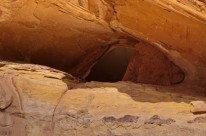



















































































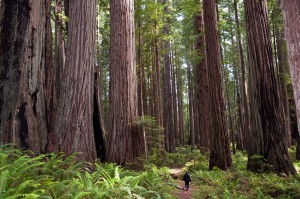



















 Soaked in the small hot springs (3 tubs) along the river. 22 June we hiked back 3 miles to Barlow Flats campground, our 3rd pretty riverside campground among the redwoods. No surprise, the food was consistently outstanding at each site (thanks to Trader Joes which has healthy and filling ready-to-eat meals – and Judi).
Soaked in the small hot springs (3 tubs) along the river. 22 June we hiked back 3 miles to Barlow Flats campground, our 3rd pretty riverside campground among the redwoods. No surprise, the food was consistently outstanding at each site (thanks to Trader Joes which has healthy and filling ready-to-eat meals – and Judi).


